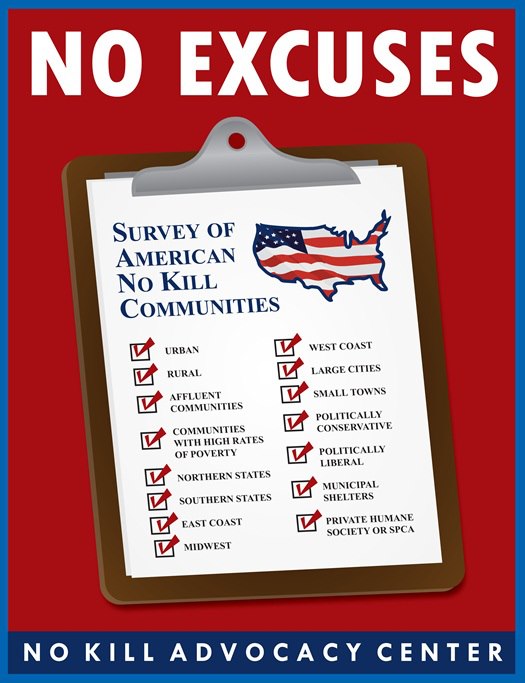
Two decades ago, the concept of a No Kill community was little more than a dream. Today, it is a reality in many cities and counties nationwide and the numbers continue to grow. And the first step is a decision by a shelter’s leadership: a commitment to reject kill-oriented ways of doing business, to replace a regressive, anachronistic 19th century model of failure with 21st century innovations by implementing the No Kill-ˆEquation. No Kill starts as an act of will.
Animals enter shelters for a variety of reasons and with a variety of needs, but for over 100 years, the “solution” has been the same: adopt a few and kill the rest. The No Kill Equation provides a humane, life-affirming means of responding to every type of animal entering a shelter, and every type of need those animals might have. Some animals entering shelters are feral cats. At traditional shelters, they are killed, but at a No Kill shelter, they are neutered and released back to their habitats. Some animals entering shelters are motherless puppies and kittens. At traditional shelters, these animals are killed as well. At a No Kill shelter, they are sent into a foster home to provide around-the-clock care until they are eating on their own and old enough to be adopted. Some animals have medical or behavior issues. At a traditional shelter, they are killed. At a No Kill shelter, they are provided with rehabilitative care and then adopted. Whatever the situation, the No-ˆKill Equation provides a lifesaving alternative that replaces killing.
While shelter leadership drives the No Kill initiative, it is the community that extends the safety net of care. Unlike traditional shelters—which view members of the public as adversaries and refuse to partner with them as rescuers or volunteers—a No-ˆKill shelter embraces the people in its community. They are the key to success: they volunteer, foster, socialize animals, staff offsite adoption venues and open their hearts, homes and wallets to the animals in need. The public is at the center of every successful No Kill shelter in the nation. By working with people, implementing lifesaving programs and treating each life as precious, a shelter can transform itself.

Volunteers
Volunteers are a dedicated army of compassion and the backbone of a successful No Kill effort: they walk dogs, socialize cats, assist potential adopters and more. Volunteers make the difference between success and failure and, for the animals, life and death.
Rescue Partnerships
An adoption or transfer to a rescue group frees up cage and kennel space, reduces expenses for feeding, cleaning and killing and improves a community’s rate of lifesaving.
Foster Care
Volunteer foster care is a low-cost, and often no-cost, way of increasing a shelter’s capacity and caring for sick and injured or behaviorally challenged animals, thus saving more lives.
TNR
Trap-Neuter-Release (TNR) programs provide feral cats who enter shelters a vital alternative to killing.
Comprehensive Adoptions
By implementing comprehensive adoption programs—including more convenient public access hours, offsite venues and incentives—shelters can replace killing with adoptions.
Medical and Behavior Rehabilitation and Prevention
Shelters need to keep animals happy and healthy and moving efficiently through the facility. To do this, shelters must put in place thorough vaccination, handling, cleaning, socialization and care policies to prevent illness and rehabilitative efforts for those who come in sick, injured, unweaned or traumatized.
Pet Retention
Some of the reasons people surrender animals to shelters can be prevented if shelters work with people to help them solve their problems. Saving animals requires shelters to embrace innovative strategies for keeping people and their companion animals together.
Public Relations and Community Involvement
Increasing a shelter’s public exposure through marketing, public relations and partnering with community groups and businesses increases adoptions, volunteers, donations and other support.
Proactive Redemptions
One of the most overlooked opportunities for reducing killing in animal control shelters is increasing the number of lost animals returned to their families. This includes matching reports of lost animals with animals in the shelter, rehoming animals in the field and use of technology such as posting lost animals on the internet.
Low Cost, High Volume Spay & Neuter
No-cost and low-cost, high-volume spay/neuter programs increase the number of animals sterilized and reduce the number of animals entering the shelter by removing the primary barrier preventing more people from having their animals altered: cost.
Compassionate, Hard-Working Shelter Director
The final element of the No Kill Equation is the most important of all, without which all other elements are thwarted—a hard-working, compassionate shelter director who is not content to continue killing while regurgitating tired clichés about “public irresponsibility” or hiding behind the myth of “too many animals, not enough homes.” Such a director implements the programs and services of the No Kill Equation comprehensively and with integrity while holding his or her staff accountable to results and high standards.
Learn more by clicking here.
—————-
Have a comment? Join the discussion by clicking here.
My Facebook page is facebook.com/nathanwinograd. The Facebook page of my organization is facebook.com/nokilladvocacycenter. Many people mistakenly believe that the Facebook pages at No Kill Nation and No Kill Revolution are my pages. They are not.